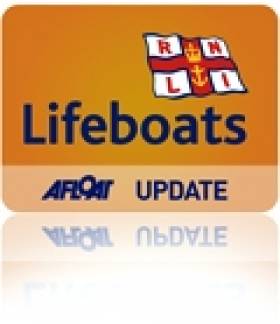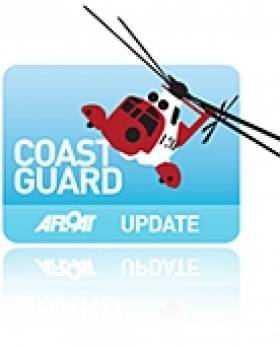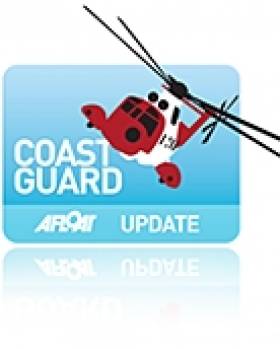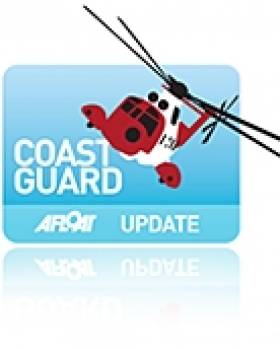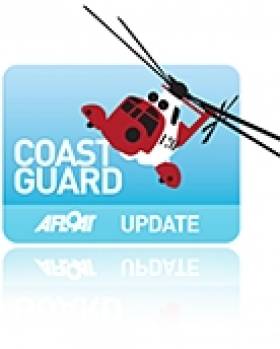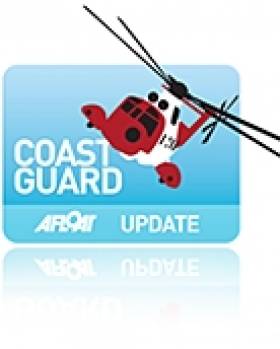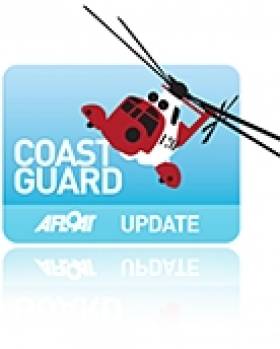Displaying items by tag: Chris Reynolds
Terry Johnson Recognised for his Work with RNLI Ireland
Approximately forty Life Governors of Irish Water Safety were in attendance at the ceremony. They included former Minister Bobby Molloy, former Director of the Coast Guard Captain Liam Kirwan, former Chairman of the National Safety Council Cartan Finnegan to name but a few. Also in attendance was Commodore Mark Mellett DSM, Flag Officer Commanding the Naval Service, Mr. Chris Reynolds current director of the Coast Guard.
Guest Speakers were Mark Mellett, Director of the Naval Service, TJ Mc Carron, Ballybunion Community Rescue Boat, Eddie Breen and County Manager of Wexford Co Co.
Irish Coast Guard Chopper Deal Could Be Model for UK
The director of the Irish Coast Guard has outlined the thinking behind its recent €500m deal for helicopter search and rescue services.
Chris Reynolds told Rotorhub that a simplified model based on key critera was adopted when choosing a bigger for the contract, which was awarded to CHC Ireland last year.
"With our contract, we essentially wanted to continue with what we already had, but with new technology," he said.
Rotorhub reports that the Irish Coast Guard formed a Future Helicopter Study Group to discuss the service's needs before the tender process which led to the 10-year deal for five Sikorsky S-92s.
The process stands in contrast to SAR-H, the UK's programme to overhaul its helicopter fleet which collapsed last year.
"If the UK needs to be looking at a new interim contract, they could look at how we did it," added Reynolds.
Rotorhub has more on the story HERE.
Speaking today, Minister for Transport Leo Varadkar TD said: This invitation to Achill Coast Guard Unit is an acknowledgement of the life-saving work that this Unit (and indeed all our Volunteer Units) around the country are engaged in every day of the year. Every day, these people selflessly risk their own lives to save others in all weathers, day and night, often in very dangerous conditions. This invitation is in recognition of their work and is an indication of the high esteem in which our Coast Guard Units are held internationally."
Achill Island Coast Guard Unit is made up of 24 volunteers who carry pagers and are available on 15 minutes' notice day and night 365 days a year. In August 2009 the Unit took part in a search and rescue operation for a person who fell into the Atlantic Ocean while fishing off the rocks near Achill Island. In response to this incident, the Achill Coast Guard rescue boat was launched together with local RNLI Ballyglass Unit and the Sligo Coast Guard helicopter during very hazardous weather conditions. The casualty (a Mr. Patrick Williamson) who amazingly stayed afloat swimming in high seas for over an hour was successfully rescued and spent 5 days in intensive care following his ordeal in the sea.
On making a full recovery, Mr. Williamson nominated Achill Island Coast Guard Unit for a National Courage Award. Previous recipients of this honour include the Irish Army (for peacekeeping duties) and former Taoiseach Mr. Bertie Ahern (for his involvement in the peace talks in Northern Ireland).
Director of the Irish Coast Guard, Mr. Chris Reynolds today said: "The Achill Coast Guard Unit is well-deserving of this honour and I congratulate them on being part of this special event. It is a great recognition of the standard and quality of service the Coast Guard provide and I thank Mr. Williamson along with all who helped make this happen for inviting them to take part in this special event."
Search and Rescue Services Firm Reports Loss
The Canadian company that provides search and rescue helicopter services for the Coast Guard has reported a €1.5 million operating loss in the 2009-2010 fiscal year, according to the Irish Independent.
CHC Ireland, the local division of the world's largest helicopter services company, operates search and rescue services out of Dublin, Shannon, Waterford and Sligo.
Directors of the firm, which employs more than 100 nationwide, noted that the loss - coming after a €3.2 million loss in the previous financial year - was reduced due to the closure of its Cork base and lower aircraft leasing costs.
Last year the Government awarded CHC a new 10-year contract worth €500 million to operate search and rescue services, despite proposals from the Air Corps that it could provide the same service at a much lower rate.
The Irish Independent reported recently that one of the world's top helicopter makers has denied claims made by the Coast Guard that the Air Corps does not have the equipment to undertake search and rescue operations.
AgustaWestland, which supplies the main helicopter used by the Air Corps, disputed allegations by Coast Guard director Chris Reynolds that the AW139 had not earned a "good reputation" elsewhere.
New World Class Coast Guard National Marine Operations Centre Opens
This morning Minister for Transport Noel Dempsey TD opened the new Irish Coast Guard National Marine Operations Centre in the Irish Coast Guard headquarters, Leeson Lane, Dublin 2.
The Irish Coast Guard National Maritime Operations Centre houses Ireland’s Maritime Rescue Coordination Centre tasked with looking after our day-to-day emergency search and rescue response needs. It also plays an important coordinating role in dealing with pollution incidents in our waters, salvage and ship casualty response, requests from ships in difficulty and control and surveillance of passing shipping and maritime infrastructure off our coast.
Speaking today Minister Dempsey said; "The opening of this centre is a very significant milestone in the development of our national maritime infrastructure. Today we are launching a new world class digital technology platform for the Irish Coast Guard. For the first time all Coast Guard sites in Ireland will be connected to a national IT system that will help better coordinate search and rescuer missions. We now have a single 24/7 international contact point on ship and port security, coast guard to coast guard requests, marine assistance services, satellite alerts and crisis response in the maritime domain. It is a vital hub that co-ordinates our response to save lives and to protect our waters."
Welcoming the formal opening today, Director of the Irish Coast Guard Chris Reynolds said: "The opening today of our new centre will considerably improve the Coast Guards ability to deliver more effective co-ordination of the national marine search and rescue (SAR) service. The systems under development here will also assist in gathering information and support risk assessments for decision making in respect of vessels seeking places of refuge and providing a vessel traffic monitoring and information service for our coastal areas. It has the technical capacity to independently run any type of incident anywhere off our coast. "
Minister Dempsey concluded: "The vision and determination shown in the past decade by the Irish Coast Guard in advancing our Search and Rescue services is an important reflection of the hard work and commitment of all parties to this project despite the current difficult financial times. In partnership with the International Maritime Organisation, the European Maritime Safety Agency, Bonn Agreement and the EU Civil Protection Mechanism, this centre reflects Ireland's commitment to the single point of contact concept for our national Search and Rescue, ship casualty and marine pollution response needs."
Coast Guard Urges Public Not to Go Out on Exposed Piers
The Irish Coast Guard service today issued an important warning to the public about high winds, gales and flooded areas. This warning comes following a weather warning and a strong gale warning issued by Met Eireann today. Southwest winds veering westerly will strengthen during this afternoon with stormy conditions becoming widespread.
Speaking today, Chris Reynolds Director of the Coast Guard said: "The public is strongly advised not to go out on exposed coasts, cliffs, piers, harbour walls, beaches, promenades or any other coastal areas. The principal dangers from this weather system will be due to gusts of 100 to 140 km/hr expected with the most severe in exposed parts of Ulster and Connacht. Showers will be heavy and thundery at times merging to give longer spells of rain in the north. Highest temperatures 9 to 11 degrees. Huge waves can be whipped up by high seas. These waves can pose hazards to anyone close to the shoreline. In coastal waters, rough seas are often the cause for capsizing fishing vessels. Some of these accidents can take place so quickly that there is no time for the crew to send out distress signals."
He continued: "Do not attempt to cross at fast running river or flood water fords as they may be stronger and deeper than you think. Flooded urban areas may contain many hazards, not least of which include submerged open manholes and downed power lines. The combination of tides, forecasted gale warnings for the next day or so, high sea conditions and swollen rivers may result in very dangerous conditions. Remember to monitor weather broadcasts when travelling and heed the advice of the RSA on road use during severe weather and high winds ."
Specific advice from the Coast Guard today is:
· Stay away from the shoreline and do not engage in water sports;
· Owners of small vessels and fishing vessels in coastal waters should seek shelterand secure them properly with moorings;
· Ships in the open sea should take heeds of weather forecasts and warnings and avoid the sea area with the most treacherous conditions.
Mr. Reynolds ended by saying: "If you do see someone in difficulty in the sea, on the shore, cliffs, lakes or rivers dial 999 or 112 and ask for the Coast Guard. "
Dempsey Applauds Irish Coast Guard as new TV Series Showcases Vital Rescue Service
Minister for Transport Noel Dempsey TD today applauded the Irish Coast Guard service as a new TV series on Ireland's national search and rescue service begins on RTE 1 this evening.
Speaking today, Minister Dempsey said: "This exciting new series will be the first time that the Irish public will get an exclusive insight into the day-to-day life saving work of the Irish Coast Guard. I hope that viewers will appreciate the superb service that the Irish Coast Guard provides, frequently in very extreme conditions and often involving very real life and death situations."
Director of the Irish Coast Guard, Mr. Chris Reynolds said, "The main role of the Irish Coast Guard is to provide Ireland with 24/7/365 maritime and coastal search and rescue service, but this isn't all we do. All around our coastline, members of the Irish Coast Guard are always on standby to provide assistance for a variety of other incidents, including emergency medical transfers, mountain rescues, searches of our rivers and lakes and providing responses to pollution control and separately, support to communities in the islands off Ireland."
Mr. Reynolds concluded: "In the next few years, the Irish Coast Guard service will see further improvements in the capacity, range, speed and capability of our search and rescue service and this will help consolidate our position as one of the most respected Coast Guard services in the world."
The Irish Coast Guard service TV series Rescue 117 begins this evening, (Tuesday 14 September 2010 on RTE 1 at 8:30pm) and runs for 6 weeks.
The contract, will provide SAR services from bases at Waterford, Dublin, Shannon and Sligo from 2012 onwards. CHC already provides SAR services from these bases but the new contract will see the existing fleet of S-61N aircraft replaced with newer Sikorsky S-92A helicopters that are custom fitted for SAR work.
Irish Coast Guard Director Chris Reynolds said, "The Irish Coast Guard provides a diverse range of maritime and land-based SAR activities, ranging from national emergency situations such as the recent flooding seen in Ireland last winter to medevac from our Islands, mountains, fishing vessels and incidents involving leisure activity."
"It is essential we have the right stepped increase in capabilities going forward for the next decade. We are very confident in selecting CHC Helicopter that our decision will continue to deliver excellence, providing the most efficient and effective SAR service for Ireland."
The Irish contract cements CHC Helicopter's position as a world leader in provision of civilian SAR services. In addition to the service already provided in Ireland, CHC currently provides SAR coverage in Australia and the UK, and through its membership in the Soteria consortium, has been identified as the preferred bidder on the UK SAR-H program, a 25-year contract to provide helicopter-based SAR services from 12 bases throughout the UK.
"CHC is internationally recognised as a provider of effective SAR solutions to customers worldwide. In today's very challenging environment, we offer the most efficient, reliable and effective services using industry leading technology," said Tilmann Gabriel, chairman of CHC Ireland and president of CHC Helicopter's European Operations.
Mark Kelly, Managing Director of CHC Ireland, added that Irish citizens could now expect to see many positive changes arise.
"Over the next decade this contract will offer a number of service improvements including the ability to deliver a paramedic to any SAR incident within an hour anywhere on our coastline, ensuring much faster treatment of casualties," he said.
CHC is the world's largest operator of the Sikorsky S-92 helicopter that has a long and distinguished pedigree in SAR operations. There are currently more than 100 S-92 helicopters in operation around the world with a fleet total approaching 250,000 flight-hours.
The state-of-the-art twin-engine aircraft will be specially equipped for SAR operations and capable of flying faster and farther than aircraft currently in use. As well as longer range and improved cruising speeds, the S-92s will be equipped with enhanced rescue mission technology including infra-red and low light cameras, a Nightsun searchlight, a satellite communications system featuring a Flight Following tracking facility, and high speed dual hoists.



























